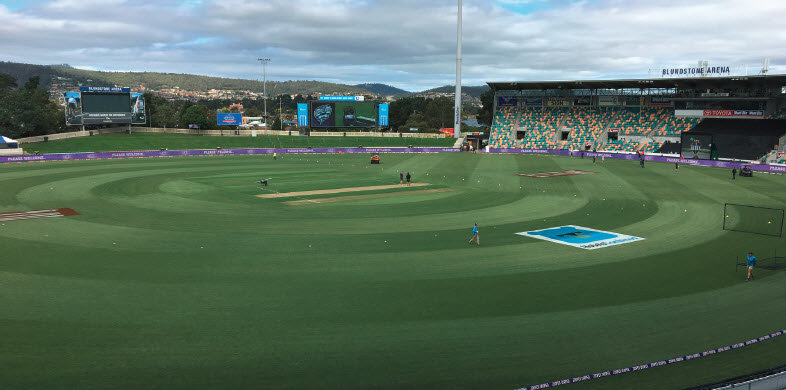Elite Continental ryegrasses rise to the challenge

Premier Tasmanian entertainment venue, Blundstone Arena, hosts a staggering array of sporting events throughout the year and that creates a great challenge for head curator, Marcus Pamplin. It takes all his 25 years of turf growing experience to manage cool season grasses so they keep up with the demands of international, national, state and local club sporting events.
Bellerive Oval is constructed with a permanent clay based 10 wicket square in the middle and 300mm deep sand based outfield. Over the warmer months, the turf is pounded by the Tasmanian Tigers, Tasmanian Roar, Hobart Hurricanes, along with club cricket and a host of emerging Tigers and Roar squads that range from Under 13’s right through to under U17’s. Marcus describes Blundstone Arena has having a ‘very heavy traffic load’ right through the year. Towards the end of autumn, Bellerive Oval must transition into the States foremost Australian Rules Football arena, hosting important local club and AFL home and away series games. And as with the cricket, over the cooler months turf on the oval must be brought up to the highest standards. “Often it has to cope with training sessions four nights a week and games, which is a massive workload in winter and summer too, so it’s a very highly used stadium,” Marcus said. He explained they rely on Barenbrug cool season continental ryegrass varieties that grow well in the local conditions.

Bellerive Oval has a permanent clay based 10 wicket square in the middle sown down to Premier II Ryegrass. Premier II is well-known for its excellent disease and winter hardiness, dense fine-leaf growth habit and aggressive growth that restricts poa annua.
Premier II Ryegrass is grown exclusively on the 10-wicket square on the clay base in the middle. Premier II is a well-known continental ryegrass ideal for cricket wickets. It is valued for its excellent disease and winter hardiness, dense fine-leaf growth habit and aggressive growth that restricts poa annua.
“With Premier II on the pitch we get virtually 90 per cent of the grass come back and the only areas we really have to re-seed are the batting creases, which are cut out by the batsmen and the bowlers.
“It’s important how we manage the grass that’s in there. We really don’t want to kill the plant with the cutting and rolling, so we leave a bit of length on it so it can get back to good health for the BBL games.
“I’ve used Premier II for 20 odd years and I’ve kept with it because it’s a really robust grass that copes with cutting and rolling. It’s also quite drought tolerant which is important when we are trying to harden up the wickets by cutting back the water. It suits our climate and comes back well.
“Importantly, it grows all year round down here and grows out in winter where we cut it to 15 to 20mm. For AFL games, it generally gets a deep water at the start of the week and we don’t want to put too much on at the end of the week when there is a football game to keep within the AFL standards.
“In the outfield, we grow RPR and Derby Xtreme. They grow well in our conditions, produce a consistent dark colour and handle both the summer and winter wear.”
Barenbrug Portfolio Manager – Turf, Matt Merrick, explained RPR and Derby Xtreme is an advanced continental ryegrass mix available to turf growers as Striker Regenerator. “Striker Regenerator contains the revolutionary RPR,” he said. “RPR is unique to Heritage. “It thrives in tough conditions, expanding even in high stress areas and it’s definitely a grass we would recommend for turf managers like Marcus, that need superior wear performance in cool conditions. “Striker Regenerator is used on the MCG for same reasons.”Marcus said he did a turf reconstruction with Striker Regenerator in August 2012.
“It took the first season of cricket for the plants to settle in and get the roots down, but it’s been worth it,” he said. “We hardly repaired a divot last year from AFL matches. Striker Regenerator performs well in our conditions, either mown low for cricket or left longer for AFL. And by reducing bare patches, it helps stop weeds like poa from establishing.”
He said they use a lot of Primo to regulate grass growth, do a lot of verti-draining and light dustings of top-soil to maintain the turf surface. RPR anchors itself really well into the sand base. They over-sow these varieties in spring and to a lesser extent in March, just towards the end of the cricket season after a shallow coring. Marcus said they do this about four to six weeks before the football season kicks off and it doesn’t disrupt the cricket season too much. “I do a significant renovation at the end of the football season, which is the last week of September. That entails a coring, three-way scarification, top-dressing 40 cubic meters of topsoil and 200kg/ha of ryegrass seed. “Through the cricket season we do light dustings of about five cubic meters and shallow coring.”

